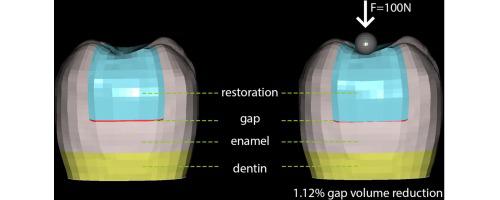当前位置:
X-MOL 学术
›
Dent. Mater.
›
论文详情
Our official English website, www.x-mol.net, welcomes your
feedback! (Note: you will need to create a separate account there.)
The effect of occlusal loading on cervical gap deformation: A 3D finite element analysis.
Dental Materials ( IF 4.6 ) Pub Date : 2020-03-29 , DOI: 10.1016/j.dental.2020.03.008 A C C Hollanders 1 , N K Kuper 1 , M C D N J M Huysmans 1 , A Versluis 2
Dental Materials ( IF 4.6 ) Pub Date : 2020-03-29 , DOI: 10.1016/j.dental.2020.03.008 A C C Hollanders 1 , N K Kuper 1 , M C D N J M Huysmans 1 , A Versluis 2
Affiliation

|
OBJECTIVES
Secondary caries can be accelerated by hydrodynamic flow in a gap between the tooth and restorative material. This study investigated whether occlusal loading can lead to increased hydrodynamic flow by deforming a gap between tooth and restorative material.
METHODS
3D finite element analysis was employed to model a molar containing a restoration with an interfacial gap. The model was loaded using direct cusp-to-restoration contact and using a rubber tube model simulating a food bolus. The object exerting pressure was moved across the molar from buccal to lingual side. The applied forces were 50, 100, 200 and 400N. The elastic modulus of the restoration material was varied between 5, 10, 15.9 and 25GPa to resemble different kinds of composite. The primary outcome parameter was the volume of the gap under occlusal pressure.
RESULTS
Occlusal loading resulted in deformation of the gap area. Maximum deformation was seen when loading was applied in the middle of the restoration. Higher forces and lower restoration stiffness led to more deformation of the gap. Maximum deformation with a force of 100N and composite modulus of 15.9GPa was -0.0083mm3 (1.12%).
SIGNIFICANCE
Deformation of the gap between tooth and restorative material could lead to increased hydrodynamic flow and faster secondary caries lesion formation. The measured deformation is small. Further research needs to show whether gap compression through occlusal loading affects secondary caries formation to a clinically relevant degree.
中文翻译:

咬合负荷对宫颈间隙变形的影响:3D有限元分析。
目的龋齿可通过牙齿与修复材料之间间隙中的流体动力流动而加速。这项研究调查了咬合负荷是否会通过使牙齿与修复材料之间的间隙变形而导致增加流体动力流动。方法采用3D有限元分析法对包含修复体和界面间隙的臼齿进行建模。使用直接的尖顶到恢复接触和模拟食物团的橡胶管模型加载模型。施加压力的物体从颊侧移至臼齿两侧。施加的力为50、100、200和400N。修复材料的弹性模量在5、10、15.9和25GPa之间变化,以类似于不同种类的复合材料。主要结果参数是咬合压力下间隙的体积。结果咬合载荷导致间隙区域变形。当在修复体中间施加载荷时,看到最大变形。较高的力和较低的恢复刚度导致间隙更大的变形。在100N的力和15.9GPa的复合模量下的最大变形为-0.0083mm3(1.12%)。意义牙齿与修复材料之间的间隙变形可能会导致流体流动增加和继发性龋齿病变形成更快。测得的变形很小。进一步的研究需要显示通过咬合负荷的间隙压缩是否在临床上相关程度影响继发性龋齿的形成。较高的力和较低的恢复刚度导致间隙更大的变形。在100N的力和15.9GPa的复合模量下的最大变形为-0.0083mm3(1.12%)。意义牙齿与修复材料之间的间隙变形可能会导致流体流动增加和继发性龋齿病变形成更快。测得的变形很小。进一步的研究需要证明通过咬合负荷造成的间隙压缩是否在临床上相关程度影响继发性龋齿的形成。较高的力和较低的恢复刚度导致间隙更大的变形。在100N的力和15.9GPa的复合模量下的最大变形为-0.0083mm3(1.12%)。意义牙齿与修复材料之间的间隙变形可能会导致流体流动增加和继发性龋齿病变形成更快。测得的变形很小。进一步的研究需要显示通过咬合负荷的间隙压缩是否在临床上相关程度影响继发性龋齿的形成。测得的变形很小。进一步的研究需要显示通过咬合负荷的间隙压缩是否在临床上相关程度影响继发性龋齿的形成。测得的变形很小。进一步的研究需要证明通过咬合负荷造成的间隙压缩是否在临床上相关程度影响继发性龋齿的形成。
更新日期:2020-03-29
中文翻译:

咬合负荷对宫颈间隙变形的影响:3D有限元分析。
目的龋齿可通过牙齿与修复材料之间间隙中的流体动力流动而加速。这项研究调查了咬合负荷是否会通过使牙齿与修复材料之间的间隙变形而导致增加流体动力流动。方法采用3D有限元分析法对包含修复体和界面间隙的臼齿进行建模。使用直接的尖顶到恢复接触和模拟食物团的橡胶管模型加载模型。施加压力的物体从颊侧移至臼齿两侧。施加的力为50、100、200和400N。修复材料的弹性模量在5、10、15.9和25GPa之间变化,以类似于不同种类的复合材料。主要结果参数是咬合压力下间隙的体积。结果咬合载荷导致间隙区域变形。当在修复体中间施加载荷时,看到最大变形。较高的力和较低的恢复刚度导致间隙更大的变形。在100N的力和15.9GPa的复合模量下的最大变形为-0.0083mm3(1.12%)。意义牙齿与修复材料之间的间隙变形可能会导致流体流动增加和继发性龋齿病变形成更快。测得的变形很小。进一步的研究需要显示通过咬合负荷的间隙压缩是否在临床上相关程度影响继发性龋齿的形成。较高的力和较低的恢复刚度导致间隙更大的变形。在100N的力和15.9GPa的复合模量下的最大变形为-0.0083mm3(1.12%)。意义牙齿与修复材料之间的间隙变形可能会导致流体流动增加和继发性龋齿病变形成更快。测得的变形很小。进一步的研究需要证明通过咬合负荷造成的间隙压缩是否在临床上相关程度影响继发性龋齿的形成。较高的力和较低的恢复刚度导致间隙更大的变形。在100N的力和15.9GPa的复合模量下的最大变形为-0.0083mm3(1.12%)。意义牙齿与修复材料之间的间隙变形可能会导致流体流动增加和继发性龋齿病变形成更快。测得的变形很小。进一步的研究需要显示通过咬合负荷的间隙压缩是否在临床上相关程度影响继发性龋齿的形成。测得的变形很小。进一步的研究需要显示通过咬合负荷的间隙压缩是否在临床上相关程度影响继发性龋齿的形成。测得的变形很小。进一步的研究需要证明通过咬合负荷造成的间隙压缩是否在临床上相关程度影响继发性龋齿的形成。











































 京公网安备 11010802027423号
京公网安备 11010802027423号